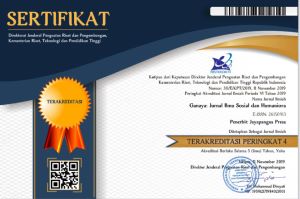Pelaksanaan, Makna Dan Nilai Pada Tradisi Ngejot Tumpeng-Anten Di Desa Pekraman Kesian
DOI:
https://doi.org/10.37329/ganaya.v4i4.3091Keywords:
Galungan, Tradition, Ngejot AntenAbstract
Hinduism has many religious holidays, especially Balinese Hinduism. One of the holy religious holidays in Bali is Galungan. Galungan Day is usually greeted with a joyful atmosphere, this is because the philosophy of Galungan Day is the day when good (dharma) wins over evil (adharma). Speaking of traditions, the island of Bali itself has so many traditions that have been passed down from ancestors and are still preserved today. Likewise, when the Galungan holiday arrives, it will also be followed by the implementation of various traditions, one of which is the Ngejot Tumpeng-Anten tradition in the Kesian Pakraman Village. This research uses qualitative research. The results of this study indicate that the Ngejot Tumpeng-Anten tradition is a tradition that means togetherness between people, as a means of establishing relationships and silahturahmi with new couples. The implementation of this tradition is divided into two stages, namely right on Galungan day and on Galungan umanis. The difference between the first and second stages of ngejot lies in the time, the anten (bride) and the gift (jotannya). The tradition of Ngejot Tumpeng during Galungan is a tradition that has a high divine (theological) value, because it is a tradition related to faith in God Almighty. The use of offerings in Balinese terms called banten in this tradition is a form of self and also Ida Sang Hyang Widhi Wasa as the ruler of the maxrocosmos (bhuana agung) and microcosmos (bhuana alit) and also the universe. The values contained in this tradition, namely the value of togetherness, the value of mutual cooperation and the value of divinity / religion.References
Anggara, D. S., & Abdillah, C. (2019). Modul Metode Penelitian. Pamulang: Fakultas Keguruan Dan Ilmu Pendidikan Universitas Pamulang.
Anggraini, P. M. R. (2019). Konsep Cakra Yadnya Terhadap Penggunaan Buah Import di Bali (Studi Kasus Perayaan Hari Raya Galungan). Jnanasiddhanta: Jurnal Teologi Hindu, 1(1).
Ardiyasa, I. N. S. (2020). Makna Filosofi Hari Raya Galungan pada Era Globalisasi. Genta Hredaya: Media Informasi Ilmiah Jurusan Brahma Widya STAHN Mpu Kuturan Singaraja, 2(1).
Arjana, I. G. B. (2021). Geografi Pariwisata Dan Ekonomi Kreatif-Rajawali Pers. Jakarta: PT. RajaGrafindo Persada.
Budiadnya, P. (2018). Tri Hita Karana Dan Tat Twam Asi Sebagai Konsep Keharmonisan Dan Kerukunan. Widya Aksara: Jurnal Agama Hindu, 23(2).
Effendhie, M. (2019). Arsip, Memori, dan Warisan Budaya. Publikasi Dan Pameran
M. Sobry, & Prosmala Hadisaputra, M. P. . (2020). Penelitian kualitatif Penelitian kualitatif. Bandung: PT. Remaja Rosda Karya
Mashita, D. (2017). Adat istiadat Masyarakat Bali. JP Books.
Musna, W. (2016). Upacara Dan Makna Filosofis Hari Raya Sugian Jawadan Sugian Bali. Vidya Samhita: Jurnal Penelitian Agama, 2(1).
Ningsih, T. (2019). Tradisi saparan dalam budaya masyarakat jawa di Lumajang. Ibda: Jurnal Kajian Islam Dan Budaya, 17(1), 79–93.
Rahmawati, N. N. (2016). Perempuan Bali dalam Pergulatan Gender. Jurnal Studi Kultural, I(1), hal. 58-64.
Saihu, S. (2021). Harmoni Hindu-Muslim Di Bali Melalui Kearifan Lokal: Studi Di Kabupaten Jembrana. Harmoni, 19(1), 7–27.
Saihu, S., & Mailana, A. (2019). Teori Pendidikan Behavioristik Pembentukan Karakter Masyarakat Muslim Dalam Tradisi Ngejot di Bali. Ta’dibuna: Jurnal Pendidikan Islam, 8(2), 163–176.
Suparman, I. N. (2019). Bentuk, Fungsi Dan Makna Tradisi Ngejot Tumpeng. Widya Genitri: Jurnal Ilmiah Pendidikan, Agama Dan Kebudayaan Hindu, 10(2), 75
Downloads
Published
How to Cite
Issue
Section
License
Copyright (c) 2021 Pande Putu Gita Widyantini, I Made Hartaka (Author)

This work is licensed under a Creative Commons Attribution-ShareAlike 4.0 International License.
An author who publishes in the Ganaya : Jurnal Ilmu Sosial dan Humaniora agrees to the following terms:
- Author retains the copyright and grants the journal the right of first publication of the work simultaneously licensed under the Creative Commons Attribution-ShareAlike 4.0 License that allows others to share the work with an acknowledgement of the work's authorship and initial publication in this journal
- Author is able to enter into separate, additional contractual arrangements for the non-exclusive distribution of the journal's published version of the work (e.g., post it to an institutional repository or publish it in a book) with the acknowledgement of its initial publication in this journal.
- Author is permitted and encouraged to post his/her work online (e.g., in institutional repositories or on their website) prior to and during the submission process, as it can lead to productive exchanges, as well as earlier and greater citation of the published work (See The Effect of Open Access).
Read more about the Creative Commons Attribution-ShareAlike 4.0 Licence here: https://creativecommons.org/licenses/by-sa/4.0/.








